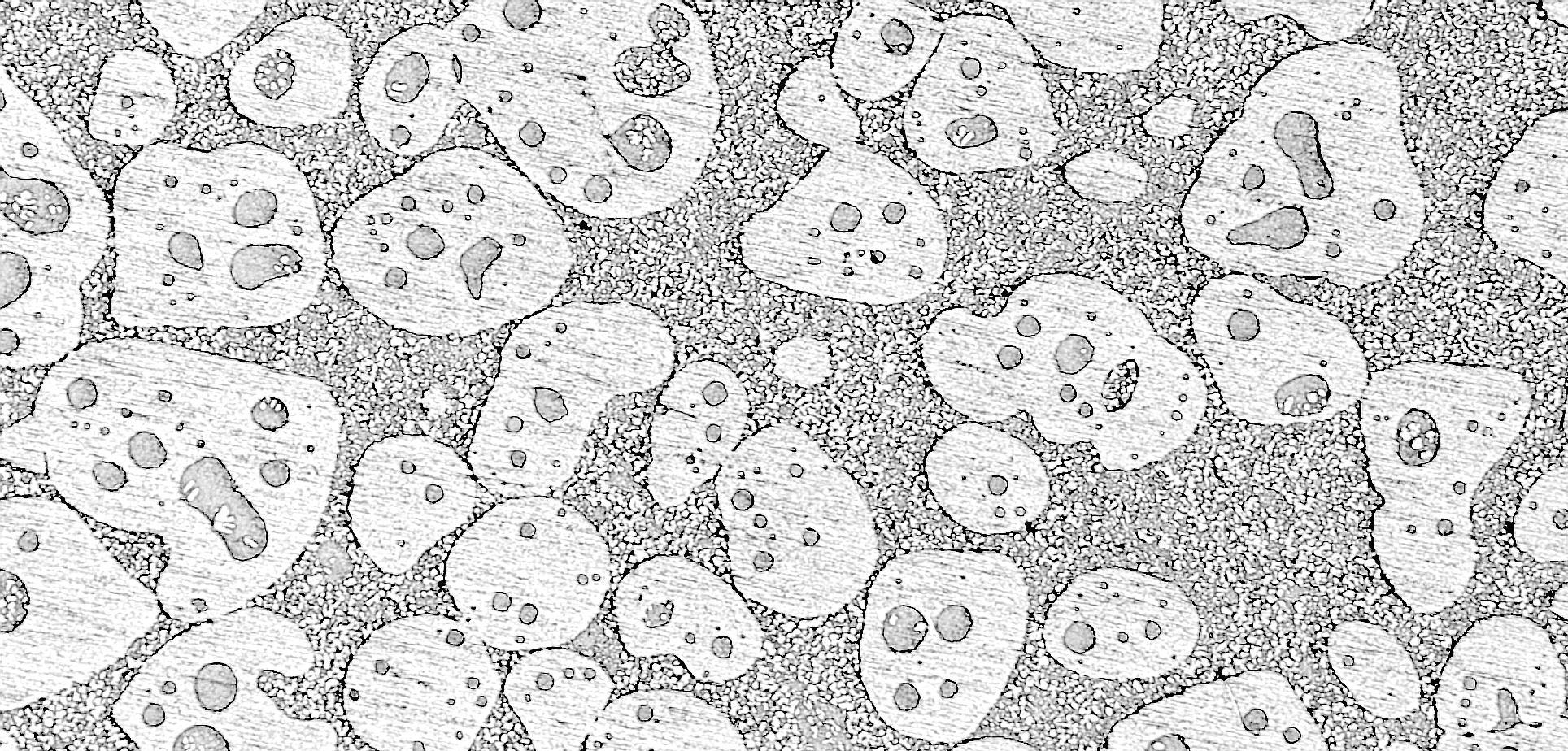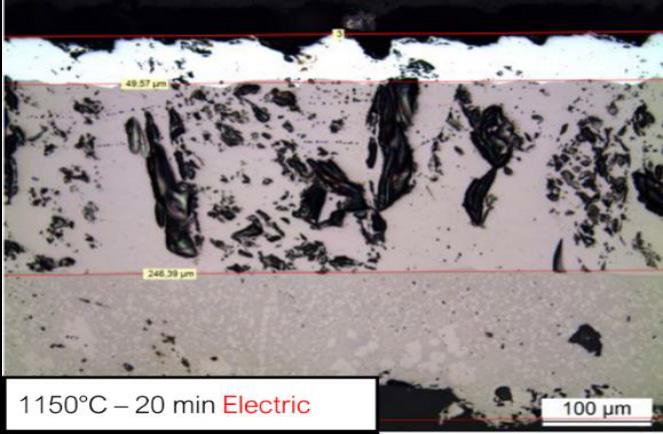
6 minute read
Oxide scale modelling on low carbon steels: kinetics characterization and failure prediction during hot-deformation processes
edited by: M. Moreno, P. Lasnes
Oxide scale growth kinetics were studied during heat treatments (up to 60 min) of low carbon steels (C22,C45, 34CrMo4 and 42CrMo4) in the typical hot-forging temperature range for steels (from 950 to 1200°C).Heat treatments were carried out using gas and electric furnaces to study the influence of the oxidizingatmosphere on the growth kinetics and evaluate the relevance of published data established under ideallaboratory conditions. The oxide scales are constituted of layers of wüstite, magnetite and hematite. Oxidephase fractions are impacted by the utilized type of furnace. Oxidation kinetics are few sensitive to the steelgrade. Regarding the utilized furnace, kinetics is very similar except when treatment time exceeds 40 min fortemperatures higher than 1100°C. Kinetics constants were calibrated on data. Oxide scale failures werestudied during hot forging by coupling AI assisted Image Analysis and FEM software FORGE® to estimatesuperficial critical failure strains. The adherence energy of oxide layers has been modelled and implementedinto a failure criterion from literature. The maximal calculated adherence of oxide layers reaches 860J.m-2.
KEYWORDS: OXIDATION KINETICS CONSTANTS, FEM MODELING, LOW CARBON STEELS, HOT-FORGING, OXIDE SCALE FAILURE, FORGE SOFTWARE, INDUSTRIAL FURNACE
Introduction
Oxidation kinetics characterization and modelling activities are carried out since decades, and continue to receive great attention so far, especially in field of hot rolling [1]. This is justified by the need in improvement for the predictability of oxidation to optimize processes efficiency, minimize material wasting and gain in cost effectiveness. Steel calamine impacts the surface properties by modifying thermal and contact properties.
In literature, authors track different objectives, namely the influence of water steam, carbon-monoxide, carbon-dioxide, oxygen, etc, using controlled atmospheres which do not reflect the industrial environments. Moreover, even though studies are carried out at elevated temperatures, sometimes the studied experimental temperature range is not suitable regarding the hot forging temperatures used in practice. Then, the motivation of current work is to characterize and model oxidation kinetics and also failure in industrial condition to discuss the relevance of published data. Subjacent objective is to implement these models in finite element simulation software (FORGE®) to permit the users to evaluate the mass of wasted material due to oxidation.
Materials And Experimental Procedure
Four steel grades where studied. Table 1 details the simplified nominal compositions. Low carbon C22 and C45 specimen, 100 mm long were cut down from long bars diameter 70 mm. The microalloyed 34CrMo4 and
Tab.1
Heat treatment procedure, oxidation kinetics and oxide scale growth and failure investigations
Three temperatures were investigated: 950, 1150 and 1200°C for 30, 45 and 60 min holding to characterize oxidation kinetics in gas or electric furnace. Oxide scale layers constitution and compositions were observed by means of optical and Scanning Electron Microscopy (SEM, BSC mode) and X-Ray diffractions (XRD). The mass of oxide formed during thermal holdings was estimated by weighing mass differences before and after oxide descaling (shot peening). Oxide scale failure was studied by capturing hot-deformation processes using a 25-fps camera. Associating Image exploitation with the Finite Element (FEM) simulation software FORGE® enables to relate the failure events with effective mechanical deformation and strain rates.
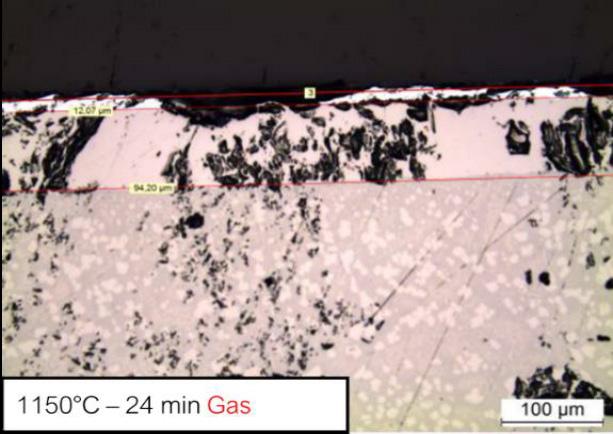
42CrMo4 specimens, 120 mm long were cut down from bars of diameter 80 mm to keep samples to a constant height / diameter ratio.
Oxide Scale Constitutions
Figure 1(a-b) shows the achieved oxide layer crosssections obtained after treatment in gas and electric furnace, respectively. Oxide consists in stacked layers of wüstite (FeO, first layer), magnetite (Fe2O3, intermediate layer) and hematite (Fe3O4, top thin bright layer)).
The nature of oxide scale has revealed to be dependent on the utilized type of furnace since scales on gas furnace are essentially made of wüstite (90%mass). The oxide mix is more balanced for oxides formed in the electric furnace. Table 2 summarizes the scales constitutions measured using XRD.
Tab.2 - Quantified oxide constituents mass fraction (XRD) after oxidation in gas and electric furnaces.
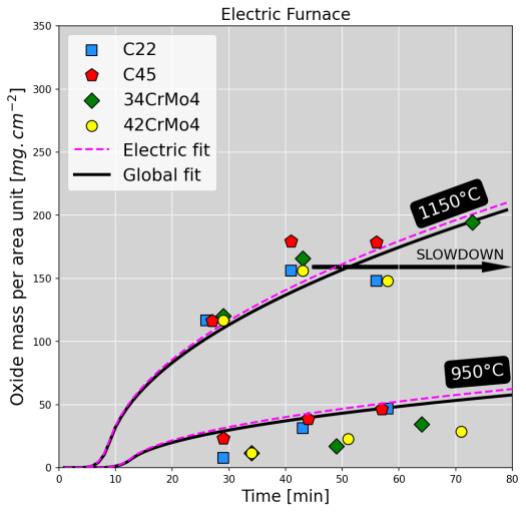
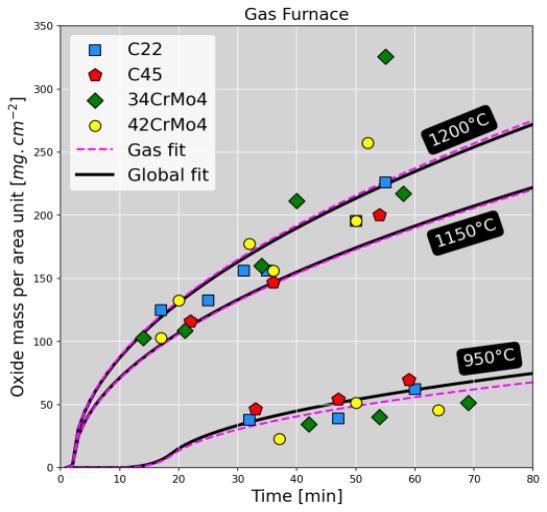
Oxidation Kinetics Characterization And Modellling
The oxidation kinetics is characterized by the evolution of the surface oxide density (mg.cm-2). The oxide mass is modelled using the Wagner’s method [2], detailed in expression (1): (1) where A is the surface area unit (cm2), ∆�� the mass weighed mass difference (g) between unoxidized / cleaned oxidized samples, t the holding time (sec) and K p the kinetics constant (g².cm-4.s-1). Kp is modelled with an Arrhenius function where f is the pre-exponential factor, Q the activation enthalpy (J.mol-1). R the ideal gas constant
(J.mol-1.K-1) and T the temperature (K). Current calibration is very consistent with data from literature [3]. Figure 2 displays the measurements (dots) as well as the oxidation kinetics predicted using the calibrated model (continuous lines).
Kinetics follow a typical parabolic trend, consistently with diffusion-controlled mechanisms (oxygen and iron cations). Even though oxide scale constitution is dependent on the furnace atmosphere, oxidation kinetics is few sensitive to the steel grade. Kinetics are very similar between both furnaces, but for temperatures higher than 1100°C in the electric furnace, a slowdown occurs after 40 min holding, no matter the studied steel. The observed kinetics slowdown is caused by a transition from wüstite to magnetite growth in which chemical components diffuse mush slower. This transition is promoted in electric furnace because the concentration in dioxygen is higher than is gas furnace where combustion consumes dioxygen and produces carbon /monoxide dioxide.
Oxide Scale Failure Identification And Oxide Adherence Determination
Image captured during sample hot forging (compression) were treated to follow the sample height as function of time. This yields to the experimental forging schedule which was reproduced in the FEM simulation software FORGE® to estimate the deformation rate and the strain anywhere on the sample surface. The locations where failures occurred have been inventoried. For this purpose, AI tools have been developed to help at identifying the true billet contours and better estimate the failure locations (Fig.3a). Once the locations are identified, it is possible to relate the failure location with its local deformation state as well as the associated strain rate by reading the simulation results at the same instant. Knowing the average scale thickness for each experiment, adhesion energy γ0 (J.m2) of oxide layer has been calculated using the method proposed by [4]. The adhesion energy is hence dependent on strain rate, temperature, and scale thickness. Figure 3b reports the distribution of calculated adhesion energies γ0 for all performed experiments.
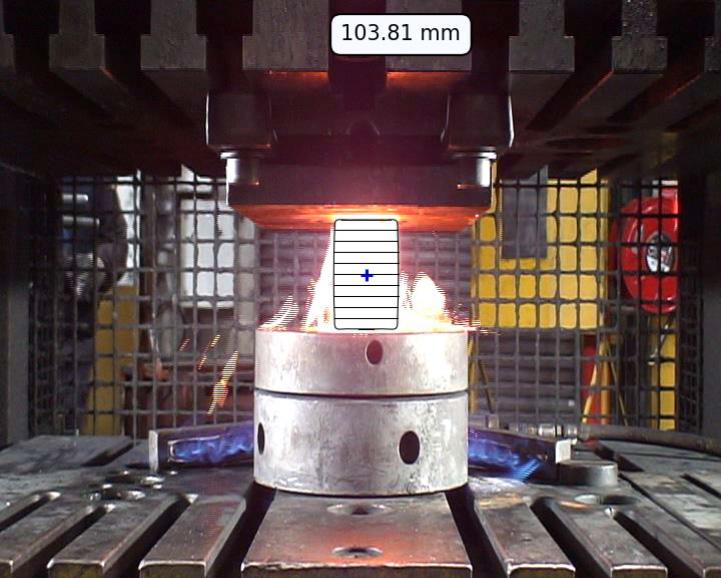
The estimated adhesion energies γ0 are in very good agreement with respect to data published by [4]. The adhesion energy ��0 has been implemented in the failure criteria proposed by [5]. This criterion is actually a critical strain εc. Hence, the failure criterion has been improved since its now takes into account the strain rate. where γ0 is the oxide layer adhesion energy (J.m-2), d the oxide scale thickness (m), E the Young’s modulus (N.m-2) and ν the Poisson ratio.
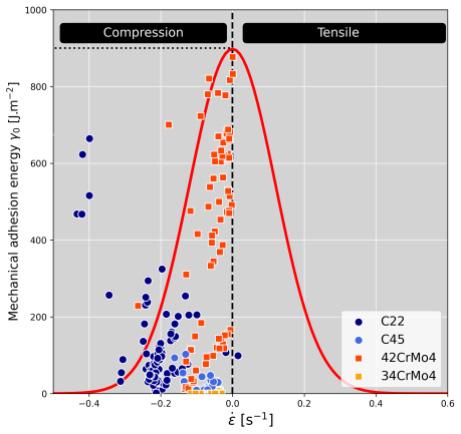
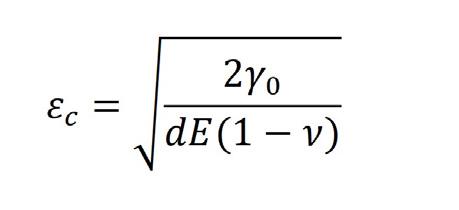
Application In Simulation For Oxide Growth And Failure
Latter investigations have conducted to the design of a new functionality in the simulation software FORGE® to permit the prediction of the oxide mass density and the mass balance of wasted material along hot forging processes. The current example in Figure 4 simulates an industrial reference case where an initial cylindric billet (to about 16 kg) is hammered (10 hits) using a 300 kg hammer. Latter investigations were utilized to build a prediction functionality combining oxide growth and failure when the critical strain is achieved. In fig.4b, the evolution of the averaged surface oxide mass density shows alternated growth – failures (blue curve) relative to the hammer hits.
(a) (b)
Fig.4 - (a) FEM simulation of hammer process (10 hits) using the FEM simulation software FORGE®. (b) Cumulated material loss due to oxidation after each hammer hit (red curve) and oxide formation kinetics between hits (red curve).
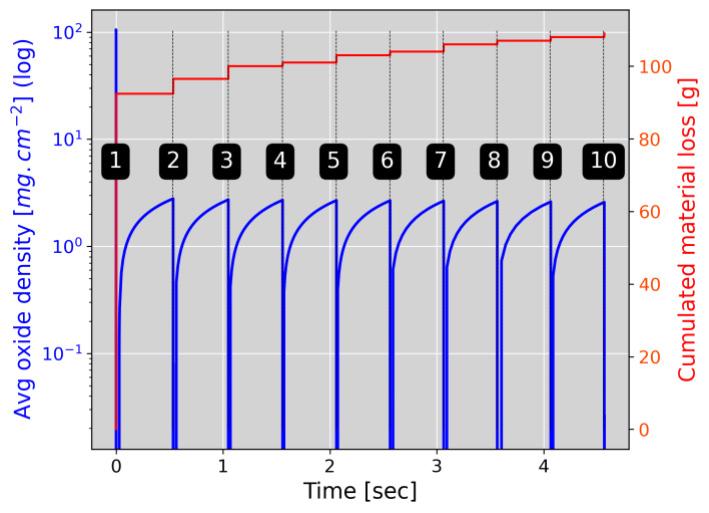
Conclusion
Oxidation kinetics of low carbon steels have been characterized in the 950 - 1200°C typical hot-forging temperature range and for times up to 60 min. This investigation includes kinetics measurements by means of microscopy, XRD and oxide weighing. Different industrial atmospheres in gas and electric furnaces were studied to verify the relevance of published laboratory data. No significant kinetics gap is observed except for holding times longer than 40 minutes in the electric furnace, because the nature of the growing oxide is changing. In addition, adhesion energy of oxide layers has been estimated and is found dependent on the temperature and the strain rate. The maximal estimated adhesion energy achieves 860 J.m-2. These investigations have permitted to optimize an existing oxide failure criterion (critical strain) proposed in literature.
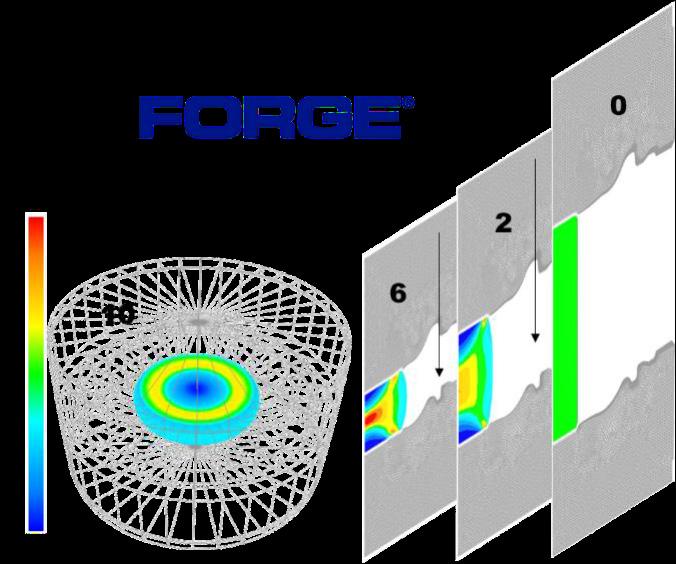
Bibliografia
[1] Sun W, Tieu AK, Jiang Z, Lu C. High temperature oxide scale characteristics of low carbon steel in hot rolling. Journal of Materials Processing Technology. Nov 2004;155-156:1307-12.
[2] Wagner C. Equations for transport in solid oxides and sulfides of transition metals. Progress in Solid State Chemistry. 1975;10:3-16.
[3] Chen RY, Yuen WYD. Review of the High-Temperature Oxidation of Iron and Carbon Steels in Air or Oxygen.
[4] Schütze M. Mechanical properties of oxide scales. Oxid Met. August 1995;44(1-2):29-61.
[5] Chandra-ambhorn S, Klubvihok N. Quantification of Adherence of Thermal Oxide Scale on Low Carbon Steel Using Tensile Test. Oxid Met. Febr 2016;85(1-2):103-25.
TORNA ALL'INDICE >




